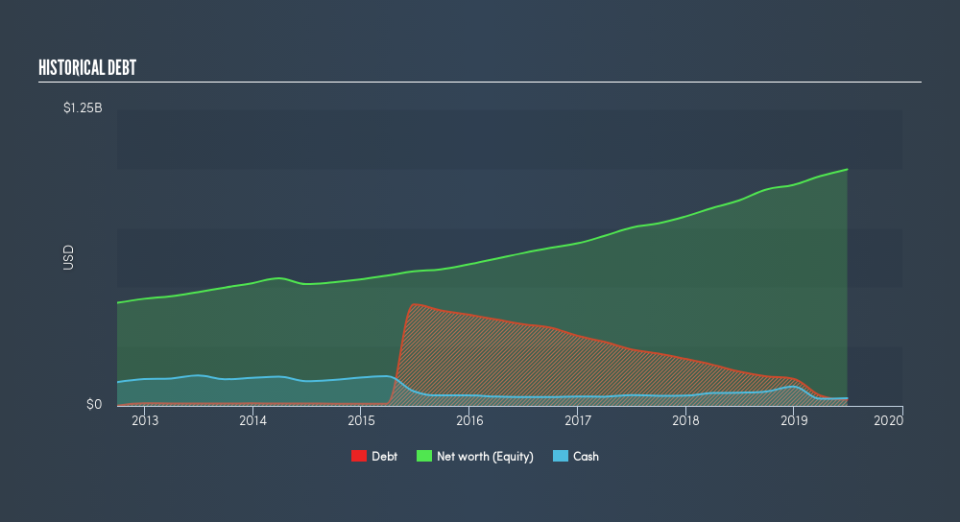Here's Why RBC Bearings (NASDAQ:ROLL) Can Manage Its Debt Responsibly

The external fund manager backed by Berkshire Hathaway's Charlie Munger, Li Lu, makes no bones about it when he says 'The biggest investment risk is not the volatility of prices, but whether you will suffer a permanent loss of capital.' So it might be obvious that you need to consider debt, when you think about how risky any given stock is, because too much debt can sink a company. Importantly, RBC Bearings Incorporated (NASDAQ:ROLL) does carry debt. But the real question is whether this debt is making the company risky.
Why Does Debt Bring Risk?
Debt is a tool to help businesses grow, but if a business is incapable of paying off its lenders, then it exists at their mercy. If things get really bad, the lenders can take control of the business. However, a more usual (but still expensive) situation is where a company must dilute shareholders at a cheap share price simply to get debt under control. Of course, the upside of debt is that it often represents cheap capital, especially when it replaces dilution in a company with the ability to reinvest at high rates of return. When we examine debt levels, we first consider both cash and debt levels, together.
View our latest analysis for RBC Bearings
What Is RBC Bearings's Debt?
The image below, which you can click on for greater detail, shows that RBC Bearings had debt of US$26.3m at the end of June 2019, a reduction from US$144.3m over a year. But on the other hand it also has US$32.7m in cash, leading to a US$6.45m net cash position.
A Look At RBC Bearings's Liabilities
Zooming in on the latest balance sheet data, we can see that RBC Bearings had liabilities of US$99.9m due within 12 months and liabilities of US$94.7m due beyond that. Offsetting these obligations, it had cash of US$32.7m as well as receivables valued at US$132.4m due within 12 months. So it has liabilities totalling US$29.5m more than its cash and near-term receivables, combined.
This state of affairs indicates that RBC Bearings's balance sheet looks quite solid, as its total liabilities are just about equal to its liquid assets. So it's very unlikely that the US$3.92b company is short on cash, but still worth keeping an eye on the balance sheet. Despite its noteworthy liabilities, RBC Bearings boasts net cash, so it's fair to say it does not have a heavy debt load!
The good news is that RBC Bearings has increased its EBIT by 8.1% over twelve months, which should ease any concerns about debt repayment. The balance sheet is clearly the area to focus on when you are analysing debt. But ultimately the future profitability of the business will decide if RBC Bearings can strengthen its balance sheet over time. So if you're focused on the future you can check out this free report showing analyst profit forecasts.
But our final consideration is also important, because a company cannot pay debt with paper profits; it needs cold hard cash. While RBC Bearings has net cash on its balance sheet, it's still worth taking a look at its ability to convert earnings before interest and tax (EBIT) to free cash flow, to help us understand how quickly it is building (or eroding) that cash balance. Over the most recent three years, RBC Bearings recorded free cash flow worth 63% of its EBIT, which is around normal, given free cash flow excludes interest and tax. This free cash flow puts the company in a good position to pay down debt, when appropriate.
Summing up
We could understand if investors are concerned about RBC Bearings's liabilities, but we can be reassured by the fact it has has net cash of US$6.4m. So is RBC Bearings's debt a risk? It doesn't seem so to us. Of course, we wouldn't say no to the extra confidence that we'd gain if we knew that RBC Bearings insiders have been buying shares: if you're on the same wavelength, you can find out if insiders are buying by clicking this link.
Of course, if you're the type of investor who prefers buying stocks without the burden of debt, then don't hesitate to discover our exclusive list of net cash growth stocks, today.
We aim to bring you long-term focused research analysis driven by fundamental data. Note that our analysis may not factor in the latest price-sensitive company announcements or qualitative material.
If you spot an error that warrants correction, please contact the editor at editorial-team@simplywallst.com. This article by Simply Wall St is general in nature. It does not constitute a recommendation to buy or sell any stock, and does not take account of your objectives, or your financial situation. Simply Wall St has no position in the stocks mentioned. Thank you for reading.

 Yahoo Finance
Yahoo Finance 
